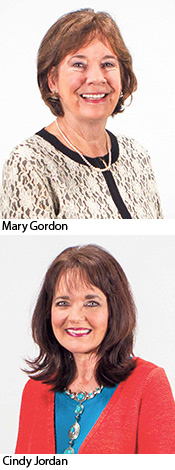Mary Gordon, nurse scientist
 A nurse for 43 years, Dr. Mary Gordon decided to become a nurse after volunteering one summer at St. Joseph Hospital. After graduating from Texas Woman’s University, she joined the Army Nurse Corps, which paid for her senior year in college.
A nurse for 43 years, Dr. Mary Gordon decided to become a nurse after volunteering one summer at St. Joseph Hospital. After graduating from Texas Woman’s University, she joined the Army Nurse Corps, which paid for her senior year in college.
“After that, I owed them two years, so during the Vietnam War, I worked at the Institute of Surgical Research in San Antonio, where burn patients were brought from the war zone for care,” Gordon said. “I had minimal training in treating burn patients, but I spent my two-year obligation there, which launched a fabulous burn-nursing career.”
She also worked at Parkland in Dallas, went back to Institute of Surgical Research for five to six years and then was recruited into pediatric burn nursing by Shriner’s Hospital in Galveston.
That hospital closed due to Hurricane Ike destruction, she said, so she began working at Texas Children’s Hospital, where she has been the past eight years. Her recent years in nursing have been spent as an advanced practice nurse – CNS, supporting patients, families and staff nurses, helping in complex cases, and helping patients and families with their clinical-care needs.
She calls her role of nurse scientist the last two years “a stretching experience. It has been challenging, but fun, too.”
Colleague Melissa J. Silvera said in her nomination:
“An exemplary clinician who has an innate ability to support and educate others about evidence-based practice and research, Dr. Gordon has been instrumental in ensuring clinical nurses maintain their enthusiasm about their projects and the opportunity to improve patient outcomes. She supports excitement about scholarly work by mentoring others.
“As a clinical nurse specialist and nurse scientist at TCH, Dr. Gordon has had a tremendous direct and indirect positive impact on the health of children and their families. Over the past year, she co-developed and co-presented an Evidence-based Nursing Practice course to clinical nurses from across TCH. More than 15 clinical nurses completed the program. She is a formal and informal mentor to nurses on the Quality Practice Council, the Nursing Research Council and the Innovative Solutions Council.
“Most recently, Dr. Gordon was instrumental in guiding and supporting a nurse-led team focused on improving oxygen saturation in infants hospitalized with bronchiolitis. When feedings via nasogastric (NG) tubes were introduced to boost nutritional status, length of hospital stay and improved patient satisfaction were studied. As a result, feedings via NG tube are being considered for inclusion in the Texas Children’s system-wide bronchiolitis clinical guideline.”
Cindy Jordan, maternal-child health
“My mother was an amazing caregiver. She was not a nurse, but she became the neighborhood’s go-to person who knew how to make anyone feel better,” said Cindy Jordan, RN.
Once her children were of school age, Jordan enrolled in the Alvin Community College nursing program and earned her RN.
“I worked the night shift,” she said. “I slept while my kids were in school and was up and ready when they got home. We went to all their after-school activities, put them to bed and went to work. My schedule worked very well.”
For the last 17 years, she has worked at Texas Children’s Hospital in maternal-child health.
“I knew I wanted to be connected to that relationship,” she said. “I wanted to teach moms what my mom taught me.”
At Texas Children’s Hospital, Jordan has worked in the community care sector, working in the field with a focus on maternal-child health.
“Our team consists of five nurses and we go into the community and work with vulnerable, low-income first-time moms,” she said. “We go into homes, teach young moms how to have a healthy pregnancy, and provide competent and responsible care and the necessary resources. At the same time we show them how to become economically self-sufficient – and many manage to break poverty cycle. We’ve offered the program to 25 moms and we work with them until their infants are 2.”
Working with these women, the nurses found poverty, domestic abuse and substance abuse. Many of the women were on their own financially – no family, no partners/husbands or consistent relationships.
“As we built trust, they became comfortable disclosing their situations and their needs,” Jordan said.
The name of the government program was the Nurse-Family Partnership (NFP) Home Visitation Program for First-time Pregnant Moms.
“During their pregnancies and after delivery, they have all of these resources,” Jordan said. “It’s a partnership between the mom and the nurse.”
Jordan said she was surprised and amazed to find out she had been chosen as one of this year’s Top 10.
“I can’t get my mind around it. I just do my job – just like all the amazing nurses I work with,” she said.

